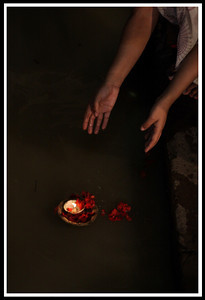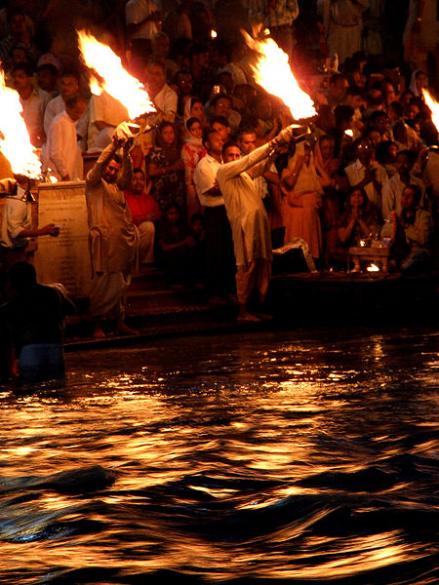We had just stepped off the rickshaw when a young boy selling charms approached us. He was too young to have a street-smart swagger. He walked towards us with the timidity of someone new to the job. A smile eased his hesitation, he stepped closer. "Hello, want to see dead body?" he said, grinning ingratiatingly, casual and breezy.
Without the context, that kind of query could throw off the most seasoned traveler.
Varanasi, the city popularized in guidebooks for its "burning ghats" has always held a morbid fascination for tourists. According to Hindu belief, dying in Varanasi liberates your soul from the cycle of death and rebirth. Bathing in the water of the Holy River Ganges washes away your sins. Considering the current pollution levels of the river a sip of that water is likely to have enough powers to relieve you of the long suffering that is life. But that is only a "bacterial" view of "purity".


Believers all over India keep bottled Ganga water at home, refrigerated, for cleansing in those final moments of departure.
If you were to station yourself in a lane close to the famous "burning ghats", you may witness the procession of souls on their way to moksha. It’s a long queue. There never seems to be enough solemnity associated with the final send-off. It’s a scene of hectic activity. It is said that if pyres were to stop burning at Manikarnika (the main burning ghat), the city would spontaneously combust.
The traffic of corpses in Banaras is an interminable flow that sometimes half burnt corpses are thrown into the river to make way for the next in line. Ashrams on the ghats host many sick and dying people from out of town; people waiting to die so their souls may be sanctified in the fires of Manikarnika. Even the shrouds are recycled. That is the "industry" Varanasi is famous for and it’s certainly not a marketing gimmick.
Banarasis are a romantic lot. Appreciation of poetry, music, literature and food is not an elitist concept in Banaras. Never in a hurry, they are generally somnolent about life (and death). I have witnessed chess games lasting hours – early morning in the December fog going into late evening, unperturbed by a projection screen being set up right above their heads for a film screening at the ghats. The film began; the players got up only when their game was over.
Walking through the network of lanes can be a rewarding experience. Sandwiched between houses piled on top of one another, you come across temples of precious antiquity, still in use. You will also be accosted by cows and bulls that look too massive in a lane which is as wide as the span of your outstretched arms.
The first sight of Banaras on the ghats is enchanting. The city rises out of the river in a crescent shape on its western shore. Ghats are basically steps rising out of the river, leading into the massive network of narrow lanes piled high with a jumble of houses, temples, palaces and ashrams. The main ghat, Dasashwamedh, is the center of all activity. As you walk further down either way, it gets less crowded. Though not solitary enough for a quiet meditative moment, the insistent Banarasi entrepreneur will find you anywhere.
Watching the sun rise at the ghats is one of the recommended activities while you are in Varanasi. The bulk of the guesthouses cater to backpackers. The ghats and the maze of narrow lanes leading up to them are choc-a-bloc full of them. Three-star and five-star hotels are a half hour rickshaw ride from the ghats, in the cantonment area. That’s where we were staying, at the Radisson. It was full of package tourists from across the globe. A clean and comfortable place, with prompt and polite service. It has a small swimming pool and the rooms are wi-fi.


We went to Varanasi at the end of the monsoon in October, on a journalistic assignment. The ghats are no fun during this season. The river is flooded and the ghats are so under water that you can’t walk along the river. Anyway, we were just in time for the evening Ganga Arati.
This ritual of worshiping the river Ganga is a relatively new activity, providing some value for money for the poor misled ones who happen to visit Varanasi when the ghats are under water. Young priests, redolent in bright yellow dhotis stand in a row, facing the river, chant mantras to an infernal din of cymbals and other instruments.
Tourists pay big money to rent boats parked opposite on the river to get a good view of the ritual. The bright halogen eyesore lamp has to be switched off for maximum effect. Having gotten their penny’s worth, the tourists head back, shaking off impish beggar children clinging to their legs for alms.
A decade back, there were no halogen streetlights on the ghats and no such ritual. It would be a quiet place after sunset. You could sit there, in the dim reflected light from the temples and houses rising behind you and hear the sound of the flowing river. If you were lucky, you could even see dolphins in moonlight.
Over the years crime against tourists has risen; local authorities feel the need to bathe the riverside in orange light in an effort to intimidate the criminals.
In the morning the place is abuzz with non-institutionalized worshippers – people bathing, meditating; enterprising priests teasing and nudging tourists into helping them unburden their souls (for a fee of course); others meditating on the cheaper chemical route to the same destination via the leaf blessed by Shiva: cannabis, ganja, hemp, assisting many on their spiritual quest.
Banaras is famous for its silk, always been a must in a North Indian bride’s trousseau. Lately with opening up of borders and trade activities between India and China, cheap fakes are flooding the market putting the handloom weavers out of business. If you can tell real from fake it might not be a bad idea to support the local economy. If you find it hard to separate yourself from your cash, just sit at the ghat, watch the river flowing past, and ponder over another way to earn good karma.
The above article can be found here too.